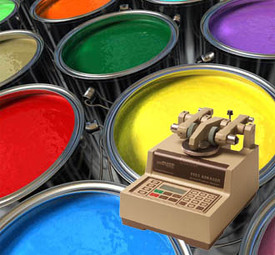Organic Coatings (ASTM D4060)
Organic Coatings (ASTM D4060)
 Situation:
Situation:
Found in numerous commercial and industrial applications, organic coatings are typically used to protect or beautify surfaces. Common types include paints; varnishes; stains; and industrial coatings.
Too often, companies tend to be more concerned about the final product appearance than the coatings’ performance. “Which colors should be offered” or “where the company logo should be painted on” are questions debated more frequently than the coating’s ability to resistance abrasion. This can be a critical mistake! Not only do coatings make your product look good, they offer protection against surface damage such as corrosion, abrasion and scratch.
Analysis:
ASTM D4060 Standard Test Method for Abrasion Resistance of Organic Coatings by the Taber Abraser is among the most common tests to evaluate the abrasion resistance of coatings. Referred to as the “Taber Test”, a coating is applied to a plane, rigid surface. The test specimen is mounted to the Taber Abraser turntable and rotated at a fixed speed under a weighted CS-10 or CS-17 abrading wheel. A vacuum system removes any loose debris generated during testing. Before each test and after every 500 cycles, the abrading wheels are resurfaced with an S-11 refacing disc to standardize the wheel surfaces. At the conclusion of the test, wear resistance can be expressed in terms of:
- Wear Index, the weight loss per specified number of revolutions (usually 1000) under a specified load (500 or 1000g);
- Wear cycles per mil, the number of cycles required to wear through a 1-mil thickness of coating; or,
- Cycles to failure, the number of test cycles to wear away the coating or to expose the substrate
But the test is not as simple as it may appear. Assuming your Taber Abraser is in calibration, variation can still be introduced into the test results. Sources that are often overlooked include:
(1) type of test plate (must be rigid and have both surfaces substantially plane and parallel)
(2) surface preparation of test plate
(3) method of application of the test film (spraying, dipping or film applicator)
(4) cure time of coating
When testing a 4” test plate is not feasible, many customers are turning to Taber’s Linear Abraser. Using the same high-quality Taber abrasive media found in our world-famous wheels, the Linear Abraser can test contoured products, providing yet another means to evaluate the robustness of a product’s coating. Although an ASTM method has yet to be established, many companies are finding cycles to failure to be a sufficient means to evaluate the performance of the coating when testing with the Linear Abraser.
Benefit:
Most consumers believe the price paid for a product is directly related to its inherent level of quality. How robust the product finish is before it becomes damaged or “worn out”, is an essential element of this perceived quality. In today’s competitive environment, manufacturers put significant efforts into minimizing production costs to remain competitive. These efforts might involve changing material suppliers or specifying a different type of finish. Unfortunately, changes are often made without the proper consideration of how they will impact product performance. Employing a meaningful test program is a necessary step to validate your product quality, and to ensure that the coating you specify will meet yours and the customer’s expectations.


